Potential Benefit of the Quadbar™ on All-Terrain Vehicles
Abstract
:1. Introduction
- Safety Criteria
- ➢
- Effective in protecting the rider in rear and side overturns
- ➢
- Improved safety in front overturns
- ➢
- High enough clearance to provide survival space in the upside-down position
- ➢
- A safe distance away from the rider to minimize impact with the rider in the event of an overturn
- ➢
- A design to minimize the chance of pinning or spearing a rider in the event of an overturn
- Operational Criteria
- ➢
- Must not restrict access and egress from the ATV or driver visibility
- ➢
- Has minimal impact on stability with low weight and low center-of-gravity
- ➢
- Must be low enough to not catch overhead branches
2. Method and Materials
2.1. Injury Severity Scales
2.2. Decision Analysis
2.2.1. Injury versus No Injury Branch
2.2.2. Fatal versus Nonfatal Branch
2.2.3. Serious versus Not Serious Branch
2.2.4. Serious Branch → Serious, Severe, and Critical Branches
2.2.5. Not Serious Branch → Minor and Moderate Branches
2.3. Benefit Analysis
2.4. Sensitivity Analyses
- One-year analytic horizon: This is an alternative to the 10-year analytic horizon.
- Emergency department cases only: This is an alternative to the addition of injuries treated in physician offices and clinics [2].
- QB = 12% effective: This is an alternative below the 40% QB effectiveness in preventing crush and collision-related injuries [9].
- QB = 80% effective: This is an alternative above the 40% QB effectiveness in preventing crush-related injuries in ATV overturns [5].
- 0% discount rate: This is an alternative to the 3% discount rate used in the economic analysis.
3. Results
4. Limitations
5. Discussion
6. Conclusions
Acknowledgments
Author Contributions
Conflicts of Interest
References
- Teutsch, S.M.; Harris, J.R. Introduction. In Prevention Effectiveness: A Guide to Decision Analysis and Economic Evaluation; Haddix, A.C., Teutsch, S.M., Corso, P.S., Eds.; Oxford University Press: New York, NY, USA, 2003; pp. 1–10. [Google Scholar]
- Topping, J.; Garland, S. 2013 Annual Report of A TV-Related Deaths and Injuries; U.S. Consumer Product Safety Commission: Bethesda, MD, USA, 2015.
- Shults, R.; West, B.A.; Rudd, R.A.; Helmkamp, J.C. All-terrain vehicle–related nonfatal injuries among young riders in the United States, 2001–2010. Pediatrics 2013, 132, 282–289. [Google Scholar] [CrossRef] [PubMed]
- Garland, S. National Estimates of Victim, Driver, and Incident Characteristics for ATV-Related, Emergency Department Treated Injuries in the United States from January 2010–August 2010 Victim, Driver, and Incident Characteristics for ATV-Related Fatalities from 2005 through 2007. In Consumer Product Safety Commission; Directorate for Epidemiology, Division of Hazard Analysis: Bethesda, MD, USA, 2014. [Google Scholar]
- Lambert, J. Public Discussion Paper; Review of Design and Engineering Control for Improving Quad Bike Safety. In QB028—John Lambert & Associates Pty; 28 September 2012. Available online: http://www.safeworkaustralia.gov.au/sites/SWA/whs-information/agriculture/quad-watch/Documents/Discussion-paper-PC/Public-submissions-L/QB028-John_Lambert_and_Associates_Pty_Ltd.PDF (accessed on 3 August 2015). [Google Scholar]
- Staight, K. On the Safe Side. ABC Landline. 14 August 2015. Available online: http://www.abc.net.au/landline/content/2015/s4280755.htm (accessed on 18 August 2015).
- Lower, T. Professor and Director of the Centre for Agricultural Health and Safety at the University of Sydney, Australia. In Inquest into Nine (9) Deaths Caused by Quad Bike Accidents; Deputy State Coroner, Office of the State Coroner Findings of Inquest: Brisbane, Australia, 2015; pp. 31–32. Available online: http://www.courts.qld.gov.au/__data/assets/pdf_file/0018/432306/cif-quadbikeaccidents-20150803.pdf (accessed on 24 October 2015). [Google Scholar]
- Robertson, D. Inquest into Nine (9) Deaths Caused by Quad Bike Accidents; Deputy State Coroner, Office of the State Coroner Findings of Inquest: Brisbane, Australia, 2015; p. 31. Available online: http://www.courts.qld.gov.au/__data/assets/pdf_file/0018/432306/cif-quadbikeaccidents-20150803.pdf (accessed on 24 October 2015).
- Anderson, R. Associate Professor Anderson’s Review of DRI’s 2012 and 2014 Computer Simulation Reports of the Quadbar. In Inquest into Nine (9) Deaths Caused by Quad Bike Accidents; Deputy State Coroner, Office of the State Coroner Findings of Inquest: Brisbane, Australia, 2015. Available online: http://www.courts.qld.gov.au/__data/assets/pdf_file/0018/432306/cif-quadbikeaccidents-20150803.pdf (accessed on 24 October 2015). [Google Scholar]
- Helmkamp, J. Vehicle Rollover Protection. In Presented at the US Consumer Product Safety Commission ATV Safety Summit, Bethesda, USA, 11–12 October 2012; Available online: http://www.slideshare.net/USCPSC/2-rollover-protection-helmkamp (accessed on 18 August 2015).
- Lambert, J. Real Life Data Proves Quad Bars Have Saved Many People from Trauma; Lambert, J., Ed.; John Lambert & Associates: Wandana Heights, Australia, 2015. [Google Scholar]
- Myers, M.L.; Pana-Cryan, R. Prevention effectiveness of roll-over protective structures part II: Decision analysis. J. Agric. Saf. Health 2000, 6, 41–55. [Google Scholar] [CrossRef] [PubMed]
- Grzebieta, R.; Rechnitzer, G.; McIntosh, A.; Mitchell, R.; Patton, D.; Simmons, K. Investigation and Analysis of Quad Bike and Side by Side Vehicle (SSV) Fatalities and Injuries (Supplemental Report). In The Quad Bike Performance Project; University of New South Wales, The Workcover Authority of New South Wales: Gosford, Australia, 2015. Available online: http://www.tars.unsw.edu.au/research/Current/Quad-Bike_Safety/Reports/Supplemental_Report_Exam&Analysis_Fatals&Injuries_Jan-2015.pdf (accessed on 2 February 2016). [Google Scholar]
- Goldie, S.F.; Corso, P.S. Decision analysis. In Prevention Effectiveness: A Guide to Decision Analysis and Economic Evaluation; Haddix, A.C., Teutsch, S.M., Corso, P.S., Eds.; Oxford University Press: New York, NY, USA, 2003; pp. 103–126. [Google Scholar]
- Messonnier, M.; Meltzer, M. Cost-Benefit Analysis. In Prevention Effectiveness; Haddix, A.C., Teutsch, S.M., Corso, P.S., Eds.; Oxford University Press: New York, NY, USA, 2003; pp. 127–155. [Google Scholar]
- Gift, T.L.; Haddix, A.C.; Corso, P.S. Cost-effectiveness Analysis. In Prevention Effectiveness: A Guide to Decision Analysis and Economic Evaluation; Haddix, A.C., Teutsch, S.M., Corso, P.S., Eds.; Oxford University Press: New York, NY, USA, 2003; pp. 156–177. [Google Scholar]
- Blincoe, L.J.; Miller, T.R.; Zaloshnja, E.; Lawrence, B.A. The Economic and Societal Impact of Motor Vehicle Crashes, 2010 (Revised); (Report No. DOT HS 812 013); National Highway Traffic Safety Administration: Washington, DC, USA, 2015.
- Zaloshnja, E.; Miller, T.; Romano, E.; Spicer, R. Crash costs by body part injured, fracture involvement, and threat-to-life, United States, 2000. Accid. Anal. Prev. 2004, 36, 415–427. [Google Scholar] [CrossRef]
- Copes, W.S.; Sacco, W.J.; Champion, H.R.; Bain, L.W. Progress in characterizing anatomic injury. In Proceedings of the 33rd Annual Meeting of the Association for the Advancement of Automotive Medicine, Baltimore, MA, USA, 2–4 October 1995; pp. 205–218.
- Ayyub, B.M. Risk Analysis in Engineering and Economics; CRC Press: New York, NY, USA, 2014; pp. 382–383. [Google Scholar]
- Helmkamp, J.C.; Biddle, E.; Marsh, S.M.; Campbell, C.R. The economic burden of all-terrain vehicle related adult deaths in the U.S. workplace, 2003–2006. J. Agric. Saf. Health 2012, 18, 233–243. [Google Scholar] [CrossRef] [PubMed]
- Helmkamp, J.C.; Aitken, M.E.; Lawrence, B.A. ATV and bicycle deaths and associated costs in the United States, 2000–2005. Public Health Rep. 2009, 124, 409–418. [Google Scholar] [PubMed]
- Lower, T.; Pollock, K.; Herde, E. Australian quad bike fatalities: what is the economic cost? Aust. N.Z. J. Public Health 2013, 37, 173–177. [Google Scholar] [CrossRef] [PubMed]
- Bentley, T.; Macky, K.; Edwards, J. Injuries to New Zealanders Participating in Adventure Tourism and Adventure Sports: An Analysis of Accident Claims Corporation (ACC) claims. N.Z. Med. J. 2006, 119, 9. Available online: http://nzma.org.nz/journal/119-124/2359/ (accessed on 8 August 2015). [Google Scholar]
- Baker, S.P.; O'Neill, B.; Haddon, W.; Long, W.B. The Injury Severity Score: A method for describing patients with multiple injuries and evaluating emergency care. J. Trauma 1974, 14, 187–196. [Google Scholar] [CrossRef] [PubMed]
- Krause, E.M.; Dyer, D.M.; Laupland, K.B.; Buckley, R. Ten years of all-terrain vehicle injury, mortality, and health care costs. J. Trauma 2010, 69, 1338–1343. [Google Scholar] [CrossRef] [PubMed]
- Wood, A.; Duijff, A.W.; Christey, G.R. Quad bike injuries in Waikato, New Zealand: An institutional review from 2007–2011. ANZ J. Surg. 2013, 83, 206–210. [Google Scholar] [CrossRef] [PubMed]
- Reynolds, S.J.; Groves, W. Effectiveness of roll-over protective structures in reducing farm tractor fatalities. Am. J. Prev. Med. 2000, 18, 63–69. [Google Scholar] [CrossRef]
- Miller, T.R.; Lawrence, B.A.; Jensen, A.F.; Waehrer, G.M.; Spicer, R.S.; Lestina, D.C.; Cohen, M.A. The Consumer Product Safety Commission’s Revised Injury Cost Model. December 2000. Available online: https://www.cpsc.gov/PageFiles/100269/costmodept1.PDF (accessed on 12 August 2015). [Google Scholar]
- Rodgers, G.B.; Adler, P. Risk factors for all-terrain vehicle injuries: A national case-control study. Am. J. Epidemiol. 2001, 153, 1112–1118. [Google Scholar] [CrossRef] [PubMed]
- Corso, P.S.; Haddix, A.C. Time Effects. In Prevention Effectiveness: A Guide to Decision Analysis and Economic Evaluation; Haddix, A.C., Teutsch, S.M., Corso, P.S., Eds.; Oxford University Press: New York, NY, USA, 2003; pp. 92–102. [Google Scholar]
- Consumer Product Safety Commission. All-Terrain Vehicle Exposure, Injury, Death, and Risk Studies; Consumer Product Safety Commission: Bethesda, MD, USA, 1998.
- Recreational Motor Vehicles includes ATV. Depreciation. pp. 13–14, Insurance Non-Depreciation Repairs at 10-years. Available online: http://www.nstarco.com/UserFiles/File/agentmanual/sd/AllStatesInlandMarine.pdf (accessed on 29 July 2015).
- Gold, M.R.; Siegel, J.E.; Russell, L.B.; Weinstein, M.C. (Eds.) Cost-Effectiveness in Health and Medicine: Report of the Panel on Cost-Effectiveness in Health and Medicine; Oxford University Press: New York, NY, USA, 1996.
- Stephens, W.B.; Ibendahl, G.A.; Myers, M.L.; Cole, H.P. Risk analysis of tractor overturns on catfish farms. J. Agromed. 2010, 15, 405–411. [Google Scholar] [CrossRef] [PubMed]
- QB Industries. Buying a Quad Bar. Available online: http://www.quadbar.com.au/the-quadbar/buying-a-quadbar.html (accessed on 24 August 2015).
- Wordley, S. Quad Bike Crush Protection Devices (CPDs): Updates to ISCRR Snapshot Review C-I-12-022; Department of Mechanical and Aerospace Engineering, Monash University: Melbourne, Australia, 2012. [Google Scholar]
- Grzebieta, R.H.; Rechnitzer, G.; McIntosh, A.S.; Mitchell, R.; Patton, D. Road related quad bike and side by side vehicle casualties. In Proceedings of the 2014 Australian Road Safety Research, Policing, and Education Conference, Melbourne, Australia, 12–14 November 2014.
- Denning, G.M.; Jennissen, C.A.; Harland, K.K. ATV-related fatalities on paved and unpaved roads: Implications for public policy. In Proceeding of the International Society for Agricultural Safety and Health 2015 Annual Conference, Normal, IL, USA, 24–27 June 2015.
- Johansson, P.; Krog, G.F.; Harlin, L.; Danielson, A.; Tysk, L.; Heimdahl, A.; Olausson, M.; Brahn, S.; Nilsson, B. Better Safety on Quad Bikes, Joint Strategy Version 1.0 for the Years 2014–2020; The Swedish Transport Administration: Bolänge, Sweden, 2013; Available online: http://www.trafikverket.se/contentassets/9b6853f0faae41949ca03184b28edb49/strategi_fyrhjuling_eng.pdf (accessed on 9 August 2015).
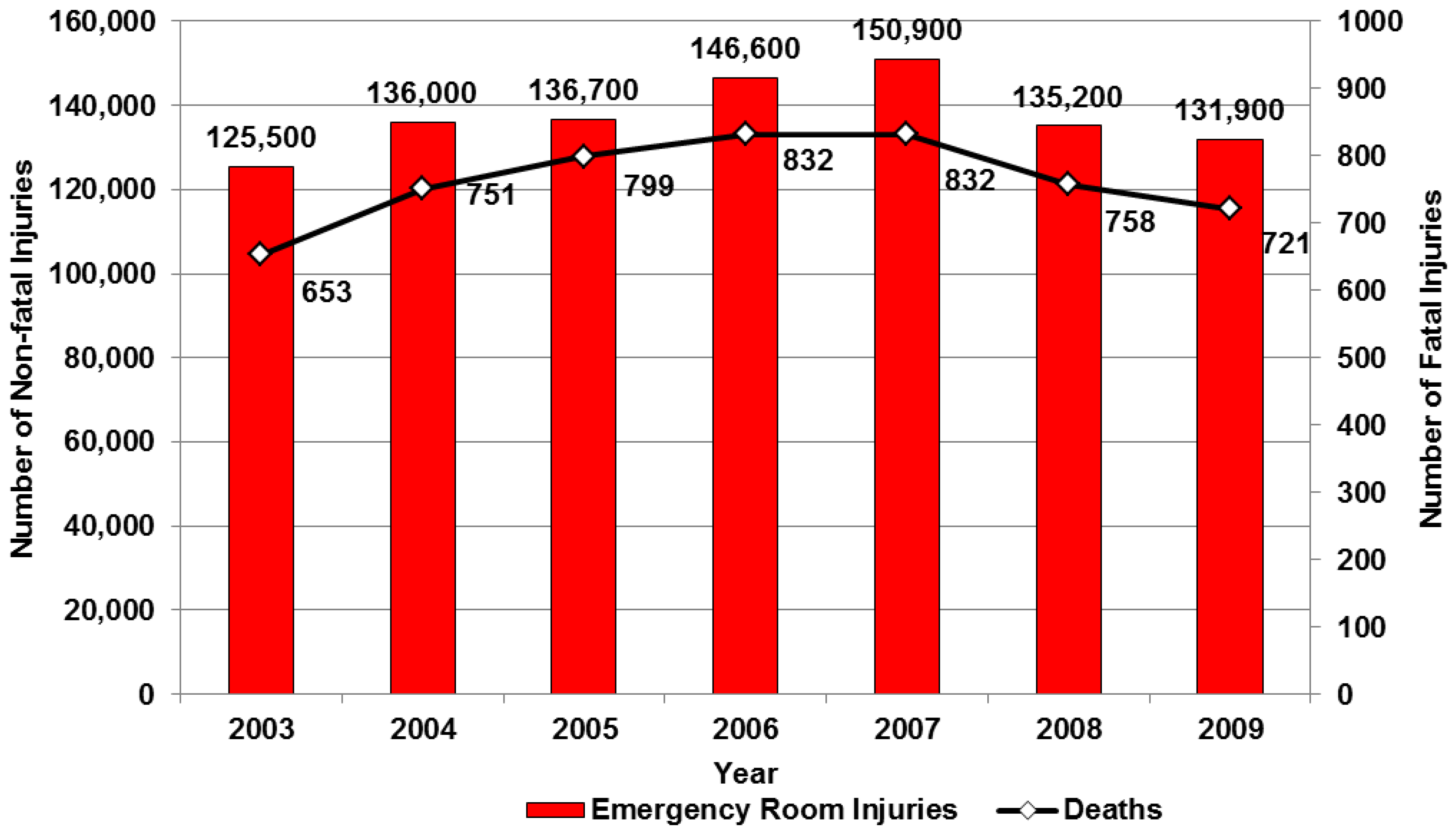
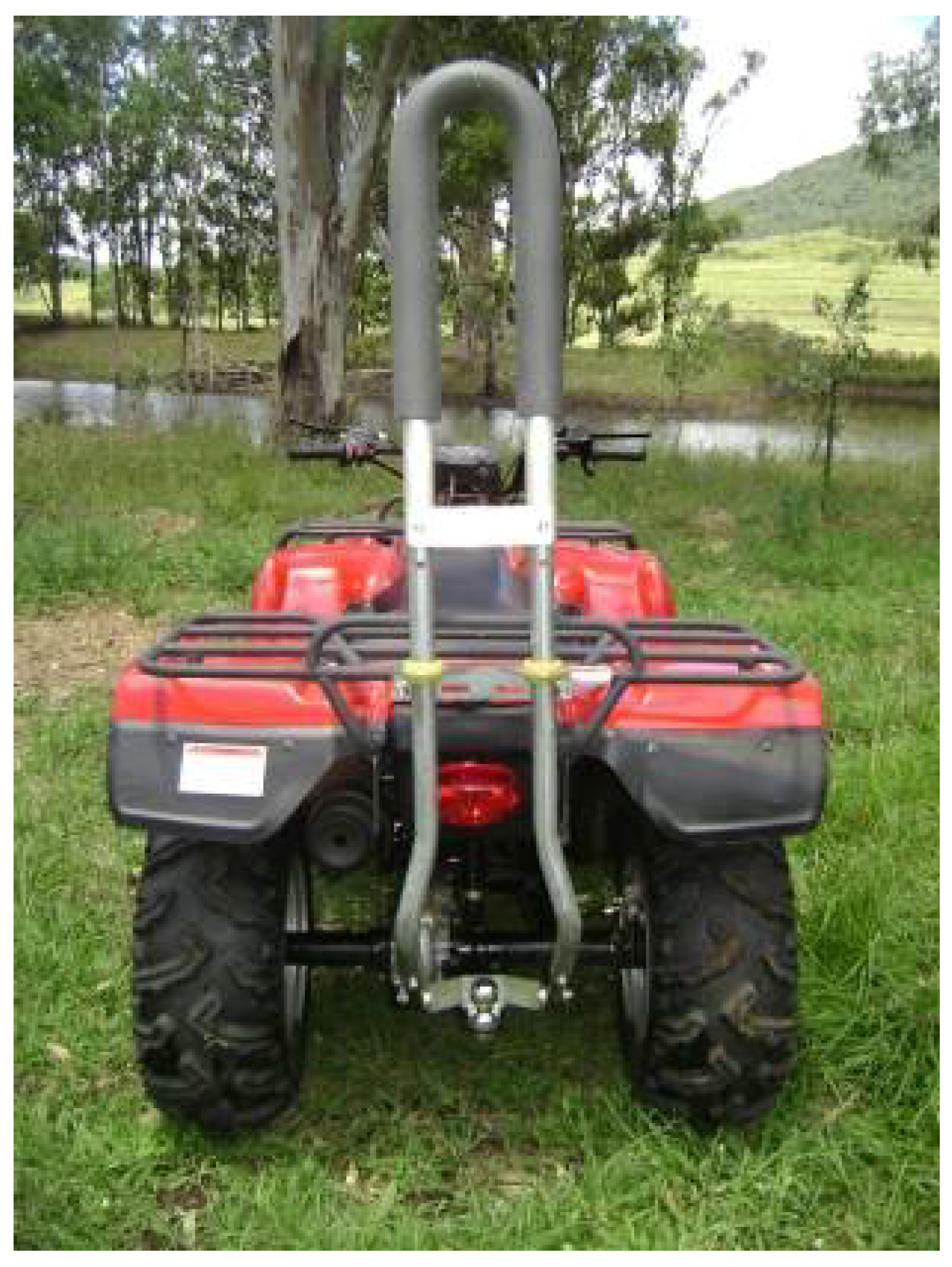
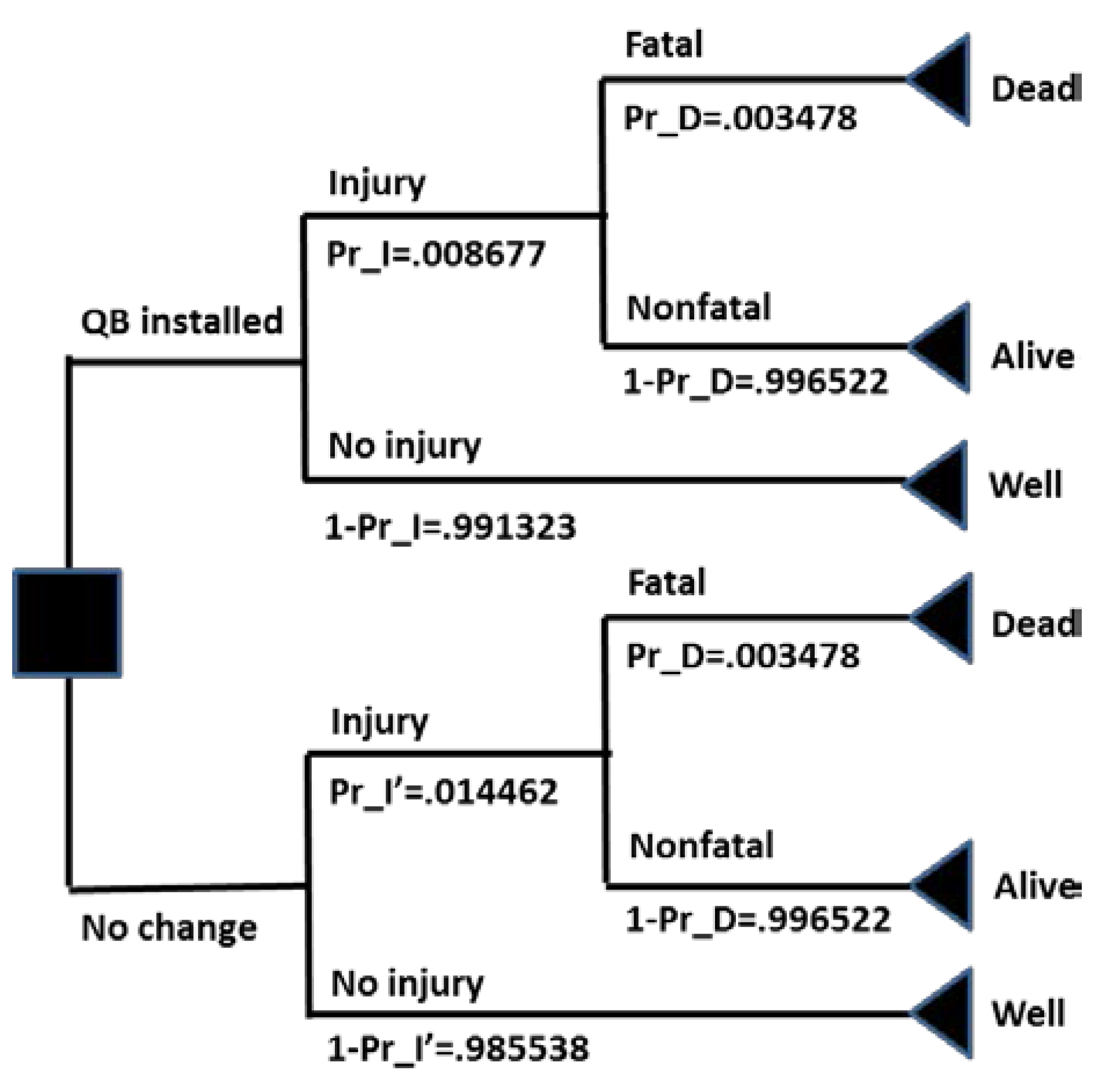
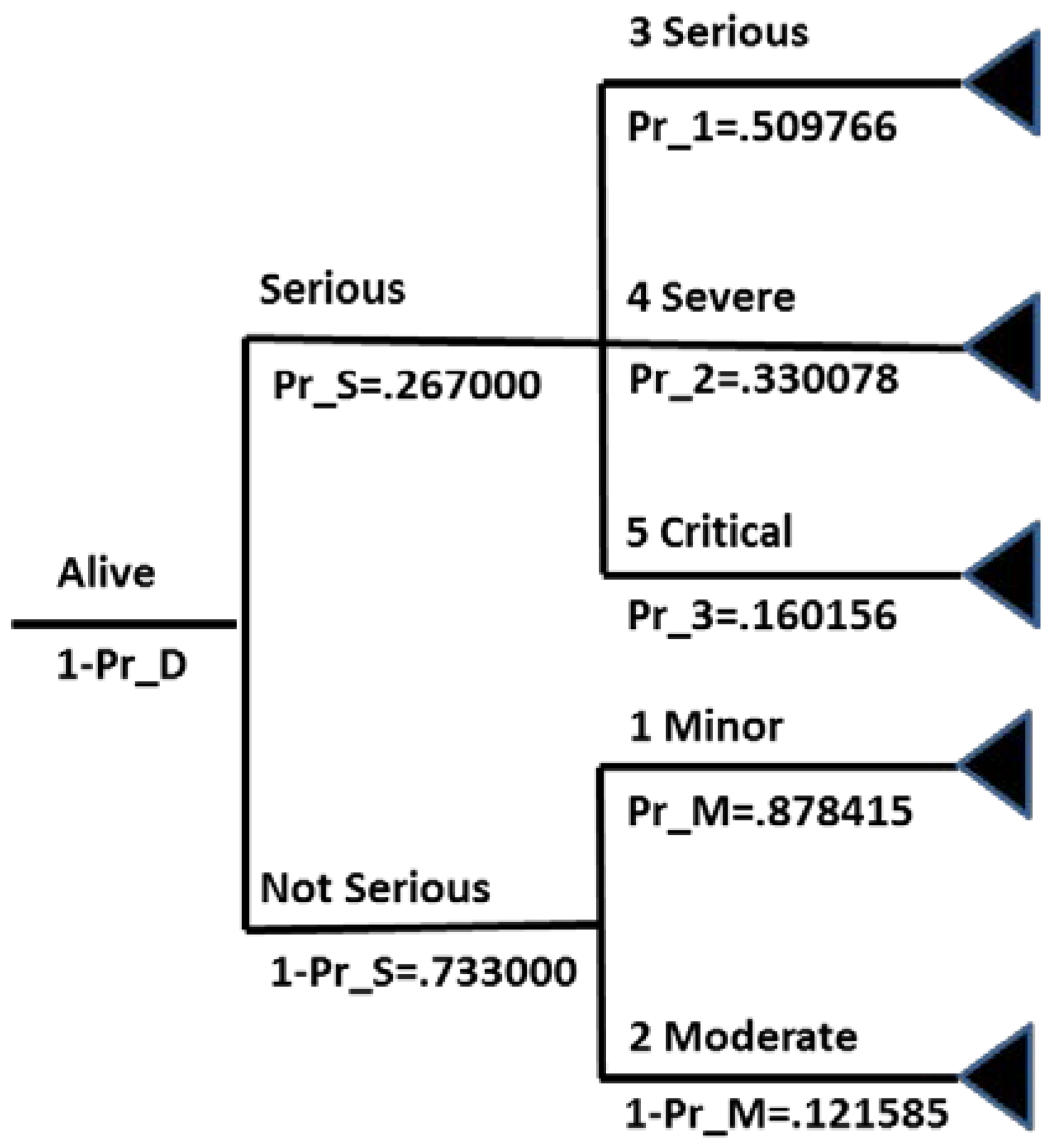
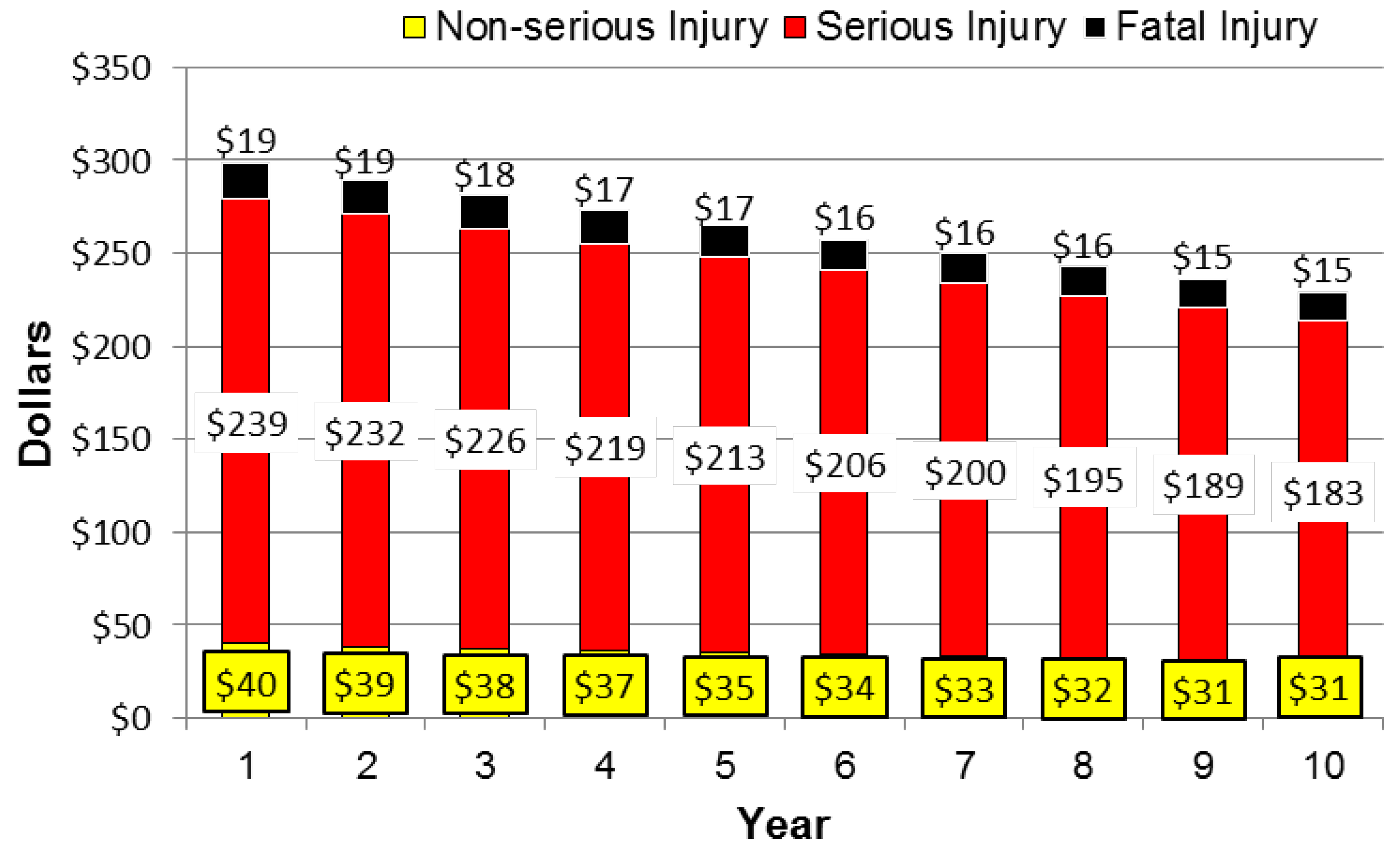
| MAIS | Selected Injuries | 2015 US$ | |
|---|---|---|---|
| 0 | No injury | $278 | |
| 1 | Minor | Superficial abrasion or laceration of skin; digit sprain; first-degree burn; head trauma with headache or dizziness | $12,314 |
| 2 | Moderate | Major abrasion or laceration of skin; concussion; finger or toe crush/amputation; closed pelvic fracture | $53,155 |
| 3 | Serious | Major nerve laceration; multiple rib fracture; abdominal organ contusion; hand, foot, or arm crush/amputation | $184,876 |
| 4 | Severe | Spleen rupture; leg crush; chest-wall perforation; concussion with other neurological signs | $410,678 |
| 5 | Critical | Spinal cord injury; extensive second- or third degree burns; cerebral concussion with severe neurological signs | $1,073,070 |
| 6 | Fatal | Injuries ultimately result in death | $1,524,818 |
| Event | Situation | Symbol | Probability per ATV‡ | Sum | Source** |
|---|---|---|---|---|---|
| Injury * | QB installed | Pr_I | 0.008677 | 1.0 | Garland, 2014 [4] Miller et al., 2000 [29] |
| Noninjury | QB installed | 1-Pr_I | 0.991323 | ||
| Injury * | No change | Pr_I′ | 0.014462 | 1.0 | |
| Noninjury | No change | 1-Pr_I′ | 0.985538 | ||
| Fatal injury | Both Choices | Pr_D | 0.003478 | 1.0 | Rodgers and Adler, 2001 [30] |
| Nonfatal Injury | 1-Pr_D | 0.996522 | |||
| Serious Injury | Both Choices | Pr_S | 0.267000 | 1.0 | Wood et al., 2014 [27] |
| Non-serious injury | 1-Pr_S | 0.733000 | |||
| Minor Injury | Both Choices | Pr_M | 0.878415 | 1.0 | Wood et al., 2014 [27] |
| Moderate Injury | 1-Pr_M | 0.121585 | |||
| Serious Injury | Both Choices | Pr_1 | 0.509766 | 1.0 | Krause et al., 2010 [26] |
| Severe Injury | Pr_2 | 0.330078 | |||
| Critical Injury | Pr_3 | 0.160156 |
| Parameter | Injuries Averted/100,000 ATVs Over 10 Years | ATV Equipped with QB (US$ 2015) | |
|---|---|---|---|
| Benefit (B10) | QB Cost (C0) | ||
| Base Case, QB 40% effective | |||
| Fatal Injuries | 17.7 | $168 | |
| Serious Injuries | 1352 | $3376 | |
| Critical AIS | 97.2 | ||
| Severe AIS | 214.6 | ||
| Serious AIS | 1040.5 | ||
| Non-Serious Injuries | 3712 | $399 | |
| Moderate AIS | 451.4 | ||
| Minor AIS | 3261.1 | ||
| Total | 5082 | $3943 | $478 |
| Sensitivity Analyses | |||
| One-year analytic horizon | 578 (−88.6%) | $449 (−88.6%) | |
| Emergency department cases only | 3175 (−37.5%) | $2521 (−36.0%) | |
| QB = 12% effective | 1525 (−70.0%) | $1183 (−70.0%) | |
| QB = 80% effective | 10,165 (+100.0%) | $7884 (+100.0%) | |
| 0% discount rate | 5785 (+13.8%) | $4486 (+13.8%) | |
| This Study Assumed That | Implication |
|---|---|
| The number of patients and decedents are discounted at the same social rate as the dollars as recommended in Gold et al. [34]. | This procedure undercounts the actual number of injuries and deaths by more than 700 cases over the analytic horizon of 10 years. See the sensitivity analysis “0% discount rate” in Table 3. |
| The proportion of overturn-related deaths is 60.6% of all fatalities related to all-terrain vehicles (ATVs). | This percentage undercounts the proportion of ATV-related overturn deaths since the cause of 18% of the deaths are unknown and many are likely overturn-related [4] |
| The proportion of overturn-related nonfatal injuries is 60.3% of all ATV-related emergency department (ED) cases, and treatments in other clinical settings were added to the analysis based on a Consumer Product Safety Commission estimate. | The ED data is considered accurate, and the added non-ED cases likely were less severe injuries (e.g., fewer hospitalizations), thus entering a bias toward more severe injuries added [29], and minor injuries not treated by physicians were likely missing. |
| ATV injury-related data reported by three levels of injury severity score (ISS) data, <10, 10–15, and >15 *, reflected abbreviated injury scale (AIS) codes of minor, moderate, and serious severity levels from a study by Wood et al. [27] which was used to differentiate serious from non-serious injuries and moderate from minor injuries. | ISS codes average the three highest AIS across six body parts, which has the effect of reducing the severity level used. Thus, the ISS injury level, ((12 + 12 + 32)/3 = 11) would be reported as a moderate injury and would not count the serious injury by body part (AIS = 3) as the highest AIS. The averaging effect can reduce reported severity and the cost of an injury, which depends on the highest AIS overall. |
| Multiple maximum abbreviated injury scale (MAIS) injury data (from a Krause et al. study) [26] by body part for a cohort with ISS data for serious ATV injuries at ≥15 * represents the probabilities of serious, severe, and critical injuries (AIS = 3, 4, and 5, respectively). | All MAIS data by body part are presented for a large cohort with multiple injuries for which the highest three AISs by six body parts are reported. Thus, a single case represents up to three data points. While the profile of injuries by severity is helpful from a probability perspective and is consistent with the injury pyramid effect with the fewer injuries at the higher severity level, some serious cases would not be counted as ISS > 15 because of the averaging effect discussed above. |
| The Blincoe et al. estimates of financial cost for motor vehicle injuries per person were proportional to the ATV fatality cost for nonfatal injuries (Figure 1) for MAIS severity levels 1–5. | The motorcycle data presented in the Blincoe et al. report [17] presented a higher proportion of more severe injuries than motor vehicle incidents overall (which could be attributed to no safety enclosure). Half of US ATV injuries occur on roads [4], and larger ATVs can reach roadway speeds. Thus, the comparison is reasonable. |
| The Helmkamp et al. study that placed the social cost of an ATV-related fatality at US$947,658 is valid for the benefit analysis as conducted. | This value does not include intangible costs such as those for pain and suffering. While the cost per person of a fatality in a previous study by Blincoe et al. of 2000 data compared closely with the US$947,658 figure in 2015 dollars, their 2010 updated study included intangible costs and totaled US$1,524,818 per fatality in 2015 dollars. Thus, the dollar value in our study appears to be undervalued. |
| The cost of a Quadbar (QB) in the United States was US$478. | The posted list price of the QB was adjusted from Australian to US dollars based on an August 2015 conversion rate of $1:$.75. The cost may be higher when accounting for shipping and installation time and lower when accounting for large order discounts or being installed as standard equipment in the manufacturing process. Nonetheless, the QB unit cost could increase by an additional US$400 and still reach a breakeven point in year 2. |
| The effectiveness of the QB to reduce overturn-related injuries is 40%. | The effectiveness of the QB as evaluated ranged from 12% to 80% in the sensitivity analyses. Across this range, the benefits exceeded the cost. |
© 2016 by the author; licensee MDPI, Basel, Switzerland. This article is an open access article distributed under the terms and conditions of the Creative Commons by Attribution (CC-BY) license (http://creativecommons.org/licenses/by/4.0/).
Share and Cite
Myers, M.L. Potential Benefit of the Quadbar™ on All-Terrain Vehicles. Safety 2016, 2, 5. https://doi.org/10.3390/safety2010005
Myers ML. Potential Benefit of the Quadbar™ on All-Terrain Vehicles. Safety. 2016; 2(1):5. https://doi.org/10.3390/safety2010005
Chicago/Turabian StyleMyers, Melvin L. 2016. "Potential Benefit of the Quadbar™ on All-Terrain Vehicles" Safety 2, no. 1: 5. https://doi.org/10.3390/safety2010005





